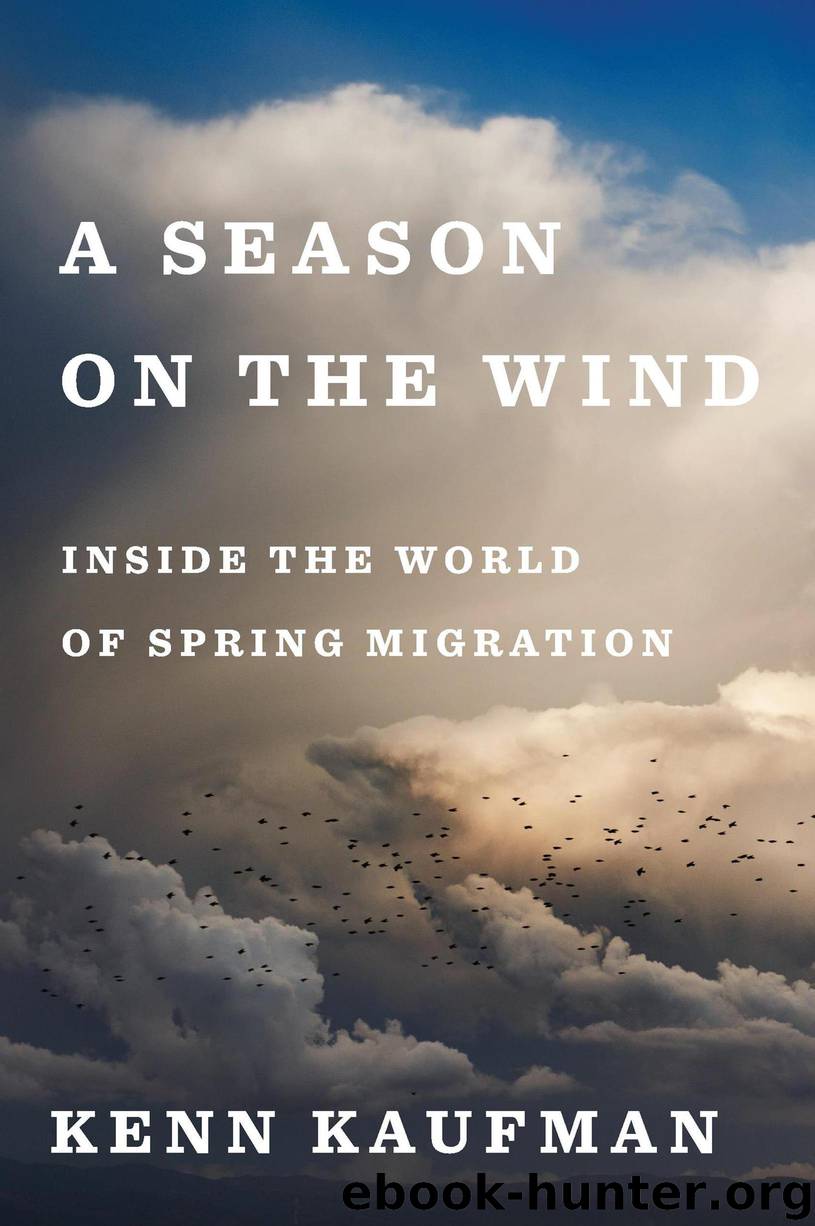A Season on the Wind by Kenn Kaufman

Author:Kenn Kaufman
Language: eng
Format: epub
Publisher: HMH Books
10
This Slice of Sky
During my years of obsession with bird migration, I have often brought up the subject in conversations with total strangers. I’ve found that most people, even if they claim no knowledge of birds at all, seem to have some ideas about how migration works. When I talk to someone about the big concentrations of migrants along the Lake Erie shoreline in northwestern Ohio, I can predict that eventually their face will light up with recognition: “Oh, you must be on a flyway!”
The whole idea of bird migration flyways seems to have seeped into the public consciousness to a surprising degree. And it’s all the more remarkable because flyways are mostly imaginary. A few kinds of birds do follow routes that fit the concept well, but for the majority of migratory birds, the very idea of flyways is irrelevant, even misleading.
To be fair, the concept had its origins in good scientific research. Frederick C. Lincoln was in charge of all bird banding in the United States from 1920 to 1946, and he built up the banding program into a serious tool for studying migration. One early focus was on the banding of migratory waterfowl, especially ducks. In order to conserve their populations and set appropriate bag limits for hunters in different regions, wildlife agencies had to know where the ducks were going. Lincoln and his Canadian counterparts organized a serious effort to band more ducks, and with band returns sent in by hunters, they soon knew more about the migrations of ducks than of any other birds.
Lincoln was interested in all birds, but for analysis he had to use the best data at hand. Compiling the points where ducks had been banded and recovered, he saw clear patterns emerging. In 1935 he published these patterns in a book, Waterfowl Flyways of North America. This landmark work set the stage for an approach to waterfowl management that has been used ever since.
Migrating ducks don’t necessarily move straight north or straight south, of course, but most of them move in at least a general north–south direction. And since they need to stop over regularly at water, they mostly avoid the deserts and the high mountains. Frederick Lincoln was thus able to ignore some sections of the country and to focus on corridors that would carry a lot of duck traffic. He called them the Atlantic, Mississippi, Central, and Pacific Flyways.
These divisions are still used as administrative units by government agencies that deal with waterfowl. In that context they work well. In each of the four named flyways, a Flyway Council of representatives from state wildlife agencies meets regularly to share information, review research, and make recommendations to the U.S. Fish and Wildlife Service. The people engaged in this work know what they’re doing; they understand that many birds angle across multiple flyways. Still, the framework provided by the four flyway groups provides a good structure for dealing with waterfowl conservation, and there’s no reason to change it.
For most birds, though, the concept doesn’t apply nearly as well.
Download
This site does not store any files on its server. We only index and link to content provided by other sites. Please contact the content providers to delete copyright contents if any and email us, we'll remove relevant links or contents immediately.
| Excursion Guides | Field Guides |
The Lonely City by Olivia Laing(4143)
Animal Frequency by Melissa Alvarez(3771)
All Creatures Great and Small by James Herriot(3542)
Walking by Henry David Thoreau(3247)
Exit West by Mohsin Hamid(3212)
Origin Story: A Big History of Everything by David Christian(3154)
COSMOS by Carl Sagan(2968)
How to Read Water: Clues and Patterns from Puddles to the Sea (Natural Navigation) by Tristan Gooley(2895)
Hedgerow by John Wright(2791)
The Inner Life of Animals by Peter Wohlleben(2781)
Origin Story by David Christian(2701)
How to Read Nature by Tristan Gooley(2677)
Project Animal Farm: An Accidental Journey into the Secret World of Farming and the Truth About Our Food by Sonia Faruqi(2675)
How to Do Nothing by Jenny Odell(2659)
Water by Ian Miller(2608)
A Forest Journey by John Perlin(2601)
The Plant Messiah by Carlos Magdalena(2468)
A Wilder Time by William E. Glassley(2374)
Forests: A Very Short Introduction by Jaboury Ghazoul(2348)
